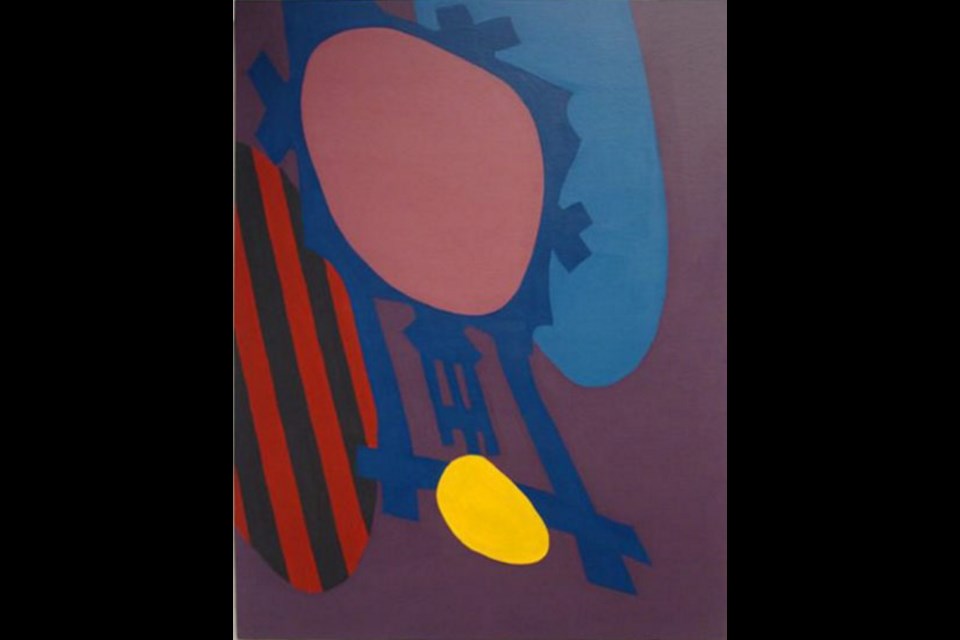 The small show of paintings by Sandra Meigs at Winchester Galleries is drawing a lot of attention. All seven paintings were sold before they were hung.
The small show of paintings by Sandra Meigs at Winchester Galleries is drawing a lot of attention. All seven paintings were sold before they were hung.
Aside from the appealing simplicity of Meigs’ painted panels, there are other reasons for this quick sale. These seven panels, each titled What is the Mind of the Mystic, are studies for a large work to be shown at her exhibition at the Art Gallery of Ontario in 2017.
That prestigious exhibit is one of the perks included with the Gershon Iskowitz $50,000 painting prize. She is also the most recent winner of the Governor General’s Award for the visual arts (other Victoria winners: Mowry Baden and Michael Morris). Meigs has taught in the visual arts department of the University of Victoria for the past 23 years.
The paintings are small panels, with simple shapes painted in even colours. The colour choices are delectable, and the shapes simply graphic. One has a trace of something that might be a doll’s face, but I felt violated by that slight intrusion of representation. I prefer the floating shapes — on a violet grey ground, a turquoise egg holds within it a soft rhomboid of vermillion.
This three-colour chord sets up a pleasant vibration. I won’t try to explain it. Meigs has a master’s degree in philosophy, but in this case looking is enough.
Winchester Galleries constantly challenge me, and sometimes it takes quite a while for the penny to drop. I am developing a taste for the very simplest paintings they show. Around the corner from the Meigs paintings are a pair of 42-inch-diameter circular canvases by Claude Tousignant.
One is dark yellow with an orange circle in the centre and, honestly, I get nothing from it. Next to it is a deep ultramarine blue circle with a green circle in the centre. The effect is wonderful. Tousignant wrote: “What I want to do is to objectify painting to bring it to its source, there where only painting remains … there where painting is only feeling.” I stood before it with my eyes open and within a minute my field of vision was awash with radiant effects, all without the intervention of my rational mind.
(By the way, the Art Gallery of Greater Victoria owns a huge Tousignant: a cat’s-eye elliptical shape. It hangs beside a narrow ramp. As I walk by it, the bands of colours expand … and then contract. I always enjoy the play of light as my eyes follow the contact between the orange and blue stripes. Try it.)
In the old days of Winchester Modern downtown, former curator Peter Redpath cultivated my interest in the paintings of William Perehudoff. Typically those are stained canvases upon which the artist has trowelled three or four slabs of acrylic colour. Can you sense my sale-resistance?
Now, at the Oak Bay Winchester, I came upon a Perehudoff painting that was strategically hung, looming out from behind a sculpture by Elza Mayhew. They both looked better for the meeting. Somebody at that gallery has rejuvenated Winchester Oak Bay’s displays, and Perehudoff is looking better to me all the time.
So, with all this late and post-modernism, what’s with all the landscapes by Dorothy Knowles? Her watercolours appear to be somewhat discursive plein air scenes, worked up to a not-very-high level of finish. More impressive are her larger acrylics, where her active compositional imagination and haphazard brushwork play out to good effect — among the abstracts.
Workshops at Emma Lake with American artists Kenneth Noland and Jules Olitski in the 1960s prompted her to thin her oil paint, and thus she was able to treat it like watercolour on a large scale. As a bonus, her charcoal underdrawings may show through. Did I mention that she was married to Perehudoff, and that they are akin to royalty in the Prairie art scene?
Terry Fenton, also showing at Winchester, lives in Victoria but was formerly director of the Edmonton Art Gallery. Fenton was that rare thing, a curator who painted. Mostly he painted factual prairie landscapes, maintaining a foothold in realism. Yet the vast sky and featureless land allowed him to paint with abandon like a late abstractionist. He had it both ways — like Dorothy Knowles. Since moving to Victoria, Fenton has usually displayed his new views of Juan de Fuca Strait, but this time the gallery prevailed upon him to bring out some older Prairie scenes.
Also noted: Graphic Blandishments at Dales Gallery (537 Fisgard St., 250-383-1552, until March 2). I enjoyed the fine graphite drawings by Ehren Salazar and also careful and mysterious drawings by Gary Pearson. But I ignored Pearson’s pencil work. I only want to talk about his marvellous mechanical sculptures.
Pearson is a professional bike mechanic who lives with his wife in his own benign, complex and somewhat gothic fantasy realm. In this installation, you’ll see two of his mechanical, geared-up and twisted assemblages. One is a sort of biplane-dragon that flaps its wings, turns its head and beats out a rhythm on the biscuit tin upon which it stands. (It’s set in motion with a foot switch.) To see one of these is like sighting a rare and extravagant bird. Pearson’s whirligigs are among the wonderful features of our landscape and he deserves a benevolent patron.
Sandra Meigs: What is the Mind of the Mystic, and other artists, at Winchester Galleries, 2260 Oak Bay Ave., 250-595-2777, until Feb. 27.



